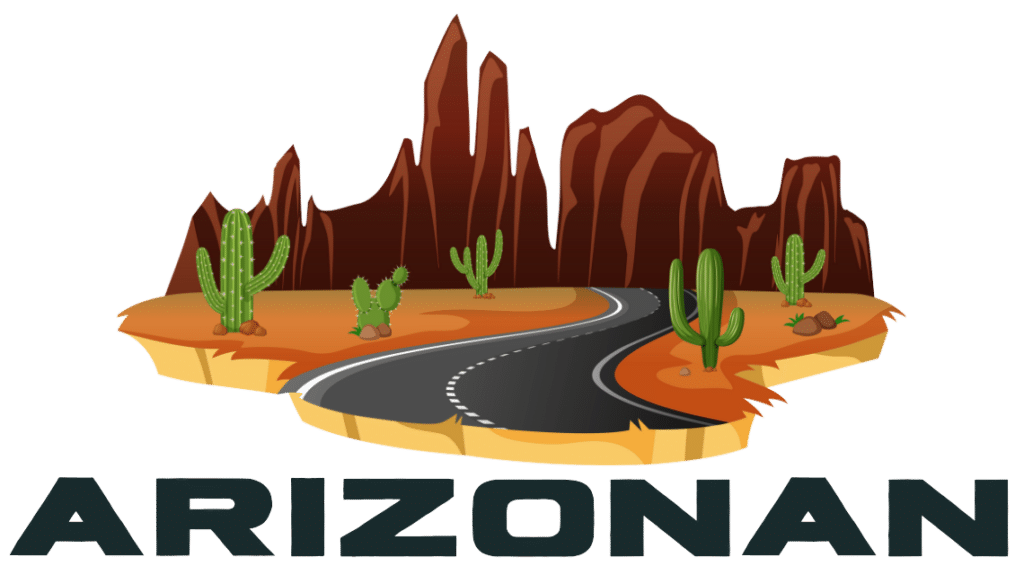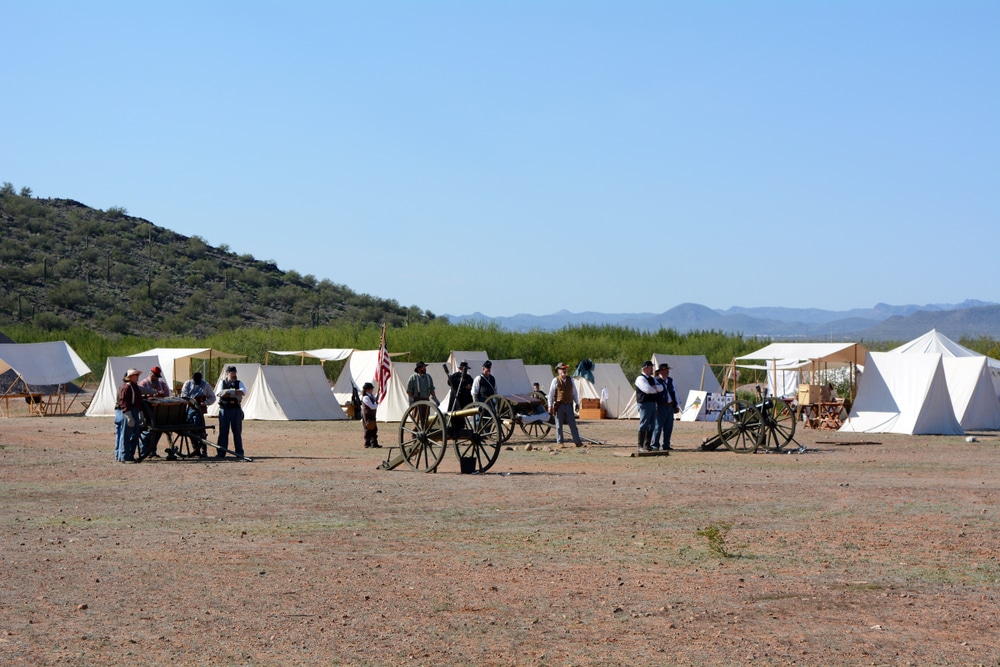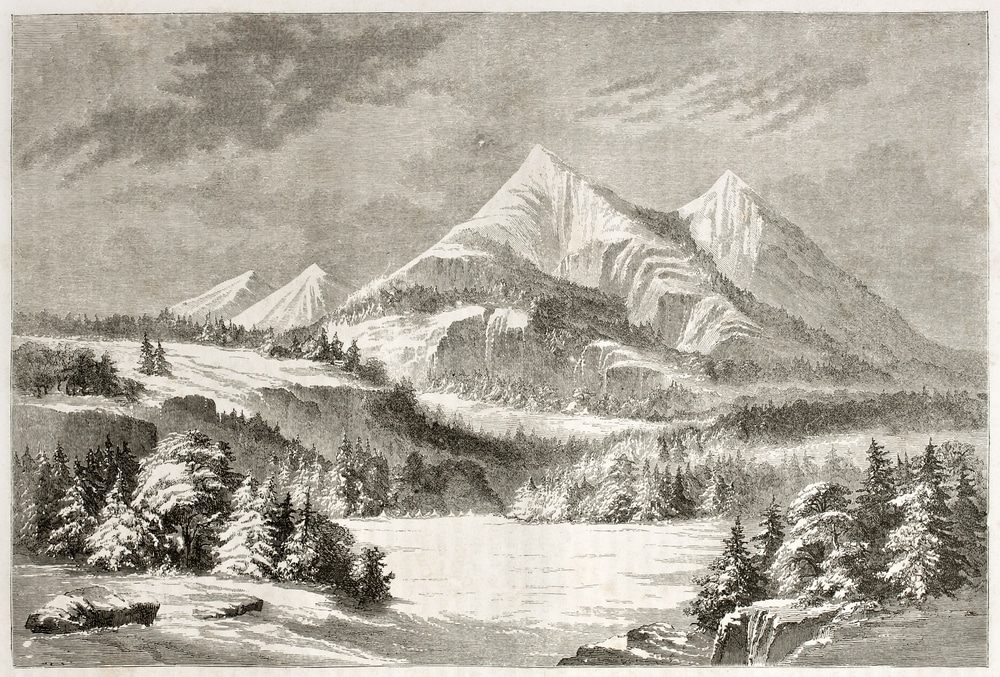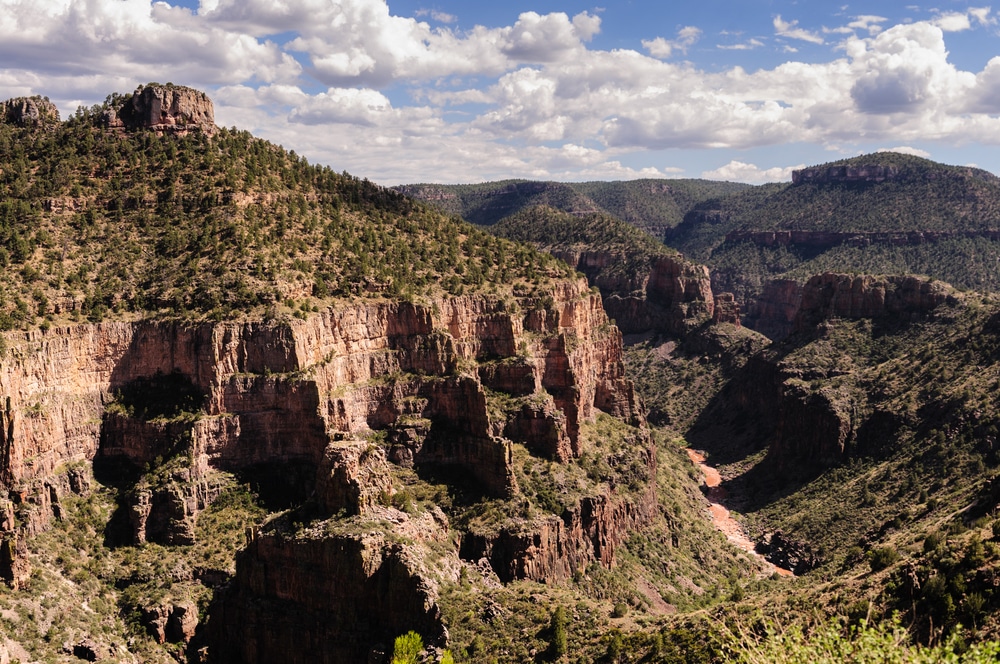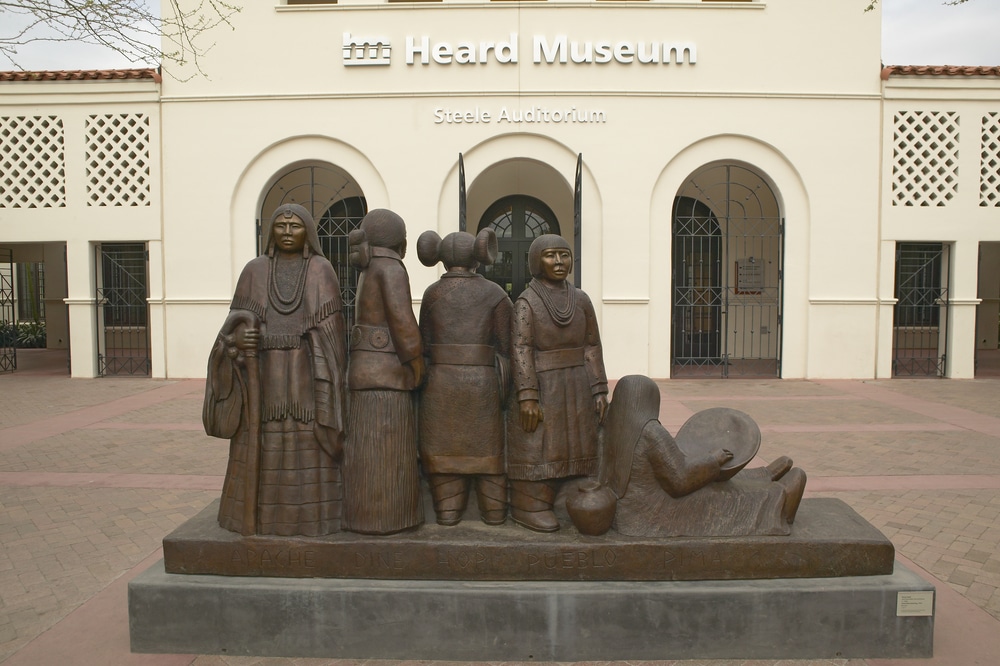The morning of April 15, 1862, broke clear and cool over the stark granite peak of Picacho Pass, halfway between Phoenix and Tucson. Union cavalry Captain William P. Calloway led his patrol of twelve men through the desert scrubland, following fresh tracks that suggested Confederate pickets were nearby. Within minutes, the westernmost battle of the American Civil War would erupt among the saguaros and palo verdes, forever marking this remote Arizona landmark as a place where brother fought brother beneath the Sonoran sun.
A Desert Divided
When the Civil War began in 1861, Arizona was still part of the New Mexico Territory, a vast expanse of desert and mountains that both Union and Confederate forces recognized as strategically vital. The Confederacy dreamed of a corridor to California’s gold fields and Pacific ports, while the Union feared losing control of the overland routes that connected the eastern states to their western territories. This grand strategic vision would ultimately play out in a brief but fierce skirmish that claimed lives and left an indelible mark on Arizona’s historical landscape.
Confederate Territory of Arizona
The Confederate Territory of Arizona had been proclaimed in August 1861 by Colonel John Baylor after his victory at the Battle of Mesilla. Unlike the modern state boundaries we know today, this Confederate Arizona comprised the southern half of both present-day Arizona and New Mexico, with its capital at Mesilla. The territory represented the Confederacy’s ambitious Western expansion plans, spearheaded by General Henry Hopkins Sibley’s New Mexico Campaign. Sibley envisioned sweeping through New Mexico, capturing the federal forts, and then pushing west to seize the gold fields of Colorado and California.
Confederate Occupation of Tucson
By early 1862, Confederate forces under Captain Sherod Hunter had occupied Tucson without firing a shot. Hunter’s Arizona Rangers, a force of about 100 men, represented the westernmost reach of Confederate military power. They raised the Confederate flag over Tucson on February 28, 1862, and began preparations to advance toward California. Hunter sent detachments to secure the Pima Villages (near present-day Phoenix) and to guard the strategic passes that controlled movement through the territory.
Union Response: The California Column
Meanwhile, Union forces were mobilizing to counter this Confederate threat. The California Column, commanded by Colonel James Henry Carleton, began its march from Fort Yuma in April 1862. This force of 2,350 volunteers from California was determined to secure Arizona for the Union and prevent any Confederate advance toward the Pacific. Carleton dispatched advance parties to scout the route and locate Confederate positions, setting the stage for the confrontation at Picacho Pass.
The Clash at Picacho
Captain William P. Calloway’s detachment from the 1st California Cavalry Regiment had been sent ahead to scout for Confederate activity around the Picacho Pass area. This narrow passage between Picacho Peak and the Picacho Mountains had long been recognized as a strategic chokepoint on the road between Tucson and the Gila River. Native peoples, Spanish colonists, and Mexican traders had all used this route, and now it would witness the only Civil War battle fought in Arizona.
The Battle Begins
On that April morning, Calloway’s men discovered fresh horse tracks leading toward a thicket of mesquite trees near the pass. The Union soldiers dismounted and advanced cautiously, but the Confederate pickets—about ten men under Sergeant Henry Holmes—had already spotted them. As recorded in Private George Johnson’s diary, discovered years later in the Arizona Historical Society archives: “The Rebels opened fire from concealment before we fairly knew they were there. The Captain called for us to charge, and charge we did, right into the teeth of their rifles.”
Chaotic Desert Combat
The battle quickly devolved into a chaotic melee. The thick desert vegetation provided cover but also obscured sight lines, turning the engagement into a series of individual firefights rather than organized military movements. Captain Calloway, leading from the front, was among the first to fall. Union Private William S. Leonard later recalled: “I saw the Captain clutch his chest and tumble from his horse. The blood spreading across his blue coat looked almost black in the morning shadows of the peak.”
Casualties and Outcome
The fighting lasted less than an hour, but its intensity was remarkable. Three Union soldiers died in the engagement: Captain Calloway, Private George Johnson, and Private William Leonard. Three others were wounded, and three were captured. The Confederates, fighting from defensive positions, suffered lighter casualties, with three wounded and two horses killed. Sergeant Holmes, recognizing that his small force was vastly outnumbered by the approaching California Column, ordered a retreat toward Tucson after the skirmish.
Strategic Consequences and Withdrawal
Though the Battle of Picacho Pass was tactically inconclusive, its strategic implications were significant. The engagement confirmed for Captain Hunter that the California Column was approaching in force. Recognizing that his hundred men could not hope to defend Tucson against Carleton’s 2,000-plus soldiers, Hunter made the decision to evacuate. On May 4, 1862, he ordered the withdrawal of all Confederate forces from Tucson, effectively ending Confederate control of western Arizona.
Union Occupation
The California Column entered Tucson on May 20, 1862, without opposition. Colonel Carleton proclaimed martial law and began establishing Union control over the territory. The dream of a Confederate corridor to the Pacific had ended, though not solely because of the skirmish at Picacho Pass. The larger Confederate defeat at Glorieta Pass in New Mexico (March 26-28, 1862) had already doomed Sibley’s New Mexico Campaign and, with it, Confederate ambitions in the Southwest.
Historical Significance
What makes Picacho Pass particularly significant is its status as the westernmost engagement of the Civil War. While larger battles raged in the East, this small skirmish in the Arizona desert represented the geographic limits of a conflict that had torn the nation apart. The men who died there—Union and Confederate alike—were thousands of miles from their homes, fighting for competing visions of America’s future in an unfamiliar landscape that must have seemed like another world entirely.
Preserving the Memory
The battlefield at Picacho Pass lay largely forgotten for decades after the war. Local ranchers occasionally found military buttons or spent bullets, but no formal recognition of the site existed. This changed in the 1920s when Arizona historians began documenting the state’s Civil War connections. The Arizona Historical Society, working with descendants of battle participants, located the approximate site of the engagement and began advocating for its preservation.
State Park Establishment
In 1928, the state of Arizona established Picacho Peak State Park, though initially more for the dramatic geological formation than for its Civil War significance. The 3,747-foot peak, a volcanic remnant that rises dramatically from the desert floor, had long served as a landmark for travelers. The Tohono O’odham people call it “I’itoi’s House,” and Spanish colonists named it “Picacho,” meaning “big peak.” The battle site received a historical marker in 1934, placed by the Daughters of the Confederacy and later supplemented with additional markers providing Union perspectives and broader historical context.
Archaeological Research
The preservation efforts gained momentum in the 1960s during the Civil War centennial. Archaeological surveys identified artifact concentrations that helped pinpoint the battle location more precisely. Metal detectors revealed bullets, buttons, and other military equipment in a pattern consistent with the historical accounts of the fighting. These findings led to expanded interpretation at the park and the establishment of protected zones around the most significant archaeological deposits.
Living History and Modern Connections
Today, Picacho Peak State Park serves as both a recreational destination and a site of historical memory. The park has developed extensive interpretive programs that place the Civil War battle within the broader context of Arizona history. Every March, the park hosts a Civil War reenactment that draws hundreds of participants and thousands of spectators. These living history demonstrations recreate not just the battle itself but also the daily life of soldiers in 1860s Arizona, complete with period camps, medical demonstrations, and military drills.
Evolving Interpretation
The reenactments, now in their fourth decade, have evolved to present a more nuanced view of the Civil War in the Southwest. Indigenous perspectives are now included, recognizing that the Apache Wars were ongoing during this period and that Native peoples viewed both Union and Confederate forces as invaders. Mexican-American perspectives are also represented, acknowledging that much of the local population had complex relationships with both sides in the conflict.
Educational Resources
The park’s visitor center features exhibits that contextualize the battle within the larger Civil War and Arizona’s territorial period. Original artifacts from the battle, including bullets, uniform buttons, and personal items, are displayed alongside interpretive panels that explain the strategic situation and the experiences of individual soldiers. A fiber-optic map demonstrates the movements of both forces, while recorded oral histories from descendants of battle participants provide personal connections to the historical events.
Experiencing the Battlefield
Beyond the formal interpretive programs, Picacho Peak State Park offers numerous hiking trails that allow visitors to experience the landscape much as the soldiers did in 1862. The Hunter Trail, named after Confederate Captain Sherod Hunter, is a challenging route to the summit that provides spectacular views of the battlefield and the surrounding Sonoran Desert. Interpretive signs along the trails point out military positions and describe the desert environment’s role in shaping the battle.
Contemporary Significance
The Battle of Picacho Pass continues to resonate in contemporary Arizona for several reasons. First, it represents Arizona’s connection to the defining conflict of American history. Though geographically distant from the major theaters of war, Arizona was not immune to the national struggle over slavery, states’ rights, and the future of the American experiment. The battle serves as a reminder that the Civil War was truly a national conflict that touched every corner of the country.
Educational Value
Second, the site provides opportunities for education about the complexities of Western history. The Civil War in Arizona cannot be understood without reference to the ongoing conflicts between the U.S. military and various Indigenous nations, the recent Mexican-American War and its territorial changes, and the diverse populations that called the region home. Modern interpretation at Picacho Peak addresses these intersecting histories, providing a more complete picture of 1860s Arizona.
Historical Memory
The battle also raises important questions about historical memory and commemoration. The various monuments at the site—erected by different groups at different times—reflect changing attitudes toward the Civil War and its legacy. Park interpreters use these monuments themselves as historical artifacts, discussing how and why certain stories were told or suppressed at various points in Arizona’s history.
Visit the History
Picacho Peak State Park
📍 Picacho Peak State Park
- Address: 15520 E Interstate 10, Picacho, AZ 85141
- 📞 Phone: (520) 466-3183
- 🌐 Website: azstateparks.com/picacho
- 🕒 Hours: 5 AM – 10 PM daily (visitor center hours vary seasonally)
- 💰 Admission: $7 per vehicle (up to 4 adults), $4 individual/bicycle
- ♿ Accessibility: Visitor center and some trails are wheelchair accessible
Arizona Historical Society Museum
📍 Arizona Historical Society Museum – Tucson
- Address: 949 E 2nd St, Tucson, AZ 85719
- 📞 Phone: (520) 628-5774
- 🌐 Website: arizonahistoricalsociety.org
- 🕒 Hours: Tuesday-Saturday, 10 AM – 4 PM
- 💰 Admission: $8 adults, $6 seniors/students, free for members and children under 12
- ♿ Accessibility: Fully accessible facilities
Annual Civil War Reenactment
📅 Annual Civil War Reenactment
- When: Second weekend in March
- 🎪 Features: Battle reenactments, period camps, civilian demonstrations, sutlers
- 🎟️ Special Event Admission: $15 adults, $10 children (includes park entry)
Conclusion
The battle at Picacho Pass may have been small in scale—a skirmish rather than a major engagement—but its significance extends far beyond the number of casualties or rounds fired. It represents the western extreme of a conflict that reshaped America, a reminder that even the most remote corners of the nation were touched by the great questions of union, freedom, and identity that the Civil War sought to resolve. Today, as visitors stand beneath the towering peak and look out across the desert battlefield, they can contemplate not just the courage of the men who fought there, but the enduring importance of understanding our shared history in all its complexity.
Additional Resources
For those seeking to explore this history further, the Arizona Historical Society maintains extensive archives related to the Civil War in Arizona, including diaries, military records, and photographs. The society offers regular lectures and educational programs that delve deeper into this period. Additionally, the Tucson Civil War Roundtable meets monthly to discuss various aspects of the war, including its Western theaters. These resources ensure that the legacy of Picacho Pass continues to educate and inspire new generations of Arizonans and visitors alike.
